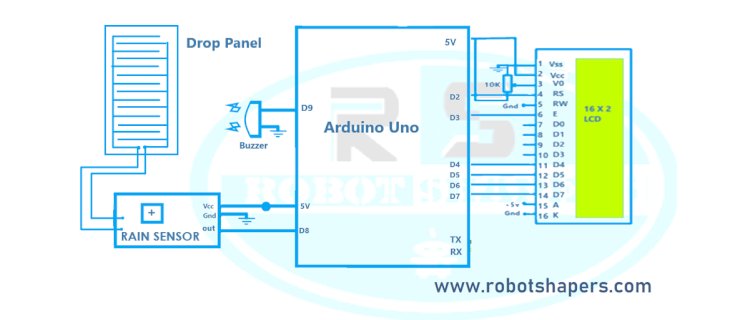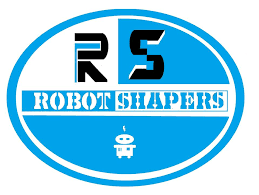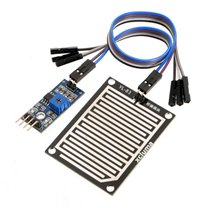Arduino Rain Sensor
Introducing Robotshapers: Shaping Automation for a Rainy World Welcome to Robotshapers.com, your gateway to innovative automation solutions. Rain or shine, we have you covered with our cutting-edge Arduino Rain Sensor. This sensor revolutionizes how we interact with rainfall, automating various systems from irrigation to car wipers.

Our rain sensor utilizes advanced LM393 comparison technology, enabling precise detection of raindrops and reliable monitoring capabilities. With simple integration and cost-effectiveness, it's the perfect solution for diverse industrial and automation applications.
Explore our website to discover the power of automation, and unleash the potential of our Arduino Rain Sensor. From conserving water in irrigation systems to enhancing driver safety on the road, Robotshapers is here to shape a brighter, rain-ready future.
Visit Robotshapers.com and step into a world of intelligent automation today!
A rain sensor, also known as a rain detector or rain switch, is a device used to measure rain and act accordingly. It is widely used in many applications including auto pipes, air conditioners and windshield wipers.
Rain sensors often contain moisture sensitive materials such as absorbent materials or conductive plates. When raindrops fall on the sensor, the humidity increases, causing the conductivity or resistance of the sensor to change. The sensor circuit then detects this change, causing the desired response.
Components required:
- Arduino Uno
- LCD (16X2)
- 10K variable resistor
- Rain sensor
- 5V DC power supply
- Buzzer
Rain sensor:
The LM393 rain sensor is a special type of rain sensor that uses the LM393 comparison circuit. It has moisture sensitive features such as water absorbing data or electronic signals and analog LM393 chip. The humidity sensor detects rain by changing the function or resistance when it rains on it. This change is converted into an electrical signal. The LM393 comparison chip compares the signal from the rain sensor to a preset voltage. When the signal exceeds the voltage indicating rain, the comparator outputs a logic high or low signal. The output of the LM393 rain sensor can be connected to other electronic devices or systems for additional operation or control. For example, it can be used to make car windshield wipers or to block water in the rain. The LM393 rain sensor provides a simple and cost-effective solution for rain applications. Its integration with the LM393 benchmark chip provides reliable monitoring capabilities, making it widely used in many industrial and automation applications.
Circuit diagram:

Code:
#include
LiquidCrystal lcd(2,3,4,5,6,7);
#define B 9// Buzzer Pin
#define S 8// Sensor Pin
void setup() {
lcd.begin(16,2);
lcd.setCursor(0,0);
lcd.print("ROBOTSHAPERS");
lcd.setCursor(0,1);
lcd.print("RAIN SENSOR");
delay(1500);
lcd.clear();
pinMode(B,OUTPUT);
pinMode(S,INPUT);
}
void loop()
{
if(digitalRead(S) == LOW)
{
lcd.setCursor(0,1);
lcd.print("RAIN ALERT");
digitalWrite(B,HIGH);
delay(500);
lcd.setCursor(0,1);
lcd.print("RAIN ALERT");
digitalWrite(B,LOW);
delay(500);
}
if(digitalRead(S) == HIGH)
{
lcd.setCursor(0,1);
lcd.print("WELCOME ");
digitalWrite(B,LOW);
}
}
Applications:
Rain sensors are widely used in many industries and fields. Below are some usage areas of rain sensors:
- Automatic Irrigation Systems: Rain sensors are widely used in automatic irrigation systems to prevent unnecessary irrigation during rain. It controls precipitation and interrupts the water cycle, saving water and improving water quality.
- Weather Monitoring: Rain sensors play an important role in weather monitoring stations and weather instruments. They provide real-time information on weather forecasting, flood monitoring, and precipitation patterns that aid water management.
- Automotive industry: Rain sensors are integrated into car windshield wiper systems. They catch rain from the windshield and automatically turn on the wipers, increasing the driver's visibility and safety.
- Home Automation: Rain sensors are used to control windows, awnings and skylights in home automation systems. They trap rainwater and close windows or retract awnings to protect interiors from water damage.
- Environmental Monitoring: Environmental monitoring uses rain gauges to collect precipitation data. This information is important for studying climate models, analyzing drought conditions, and understanding ecological impacts.

 robotshapers1
robotshapers1 


















